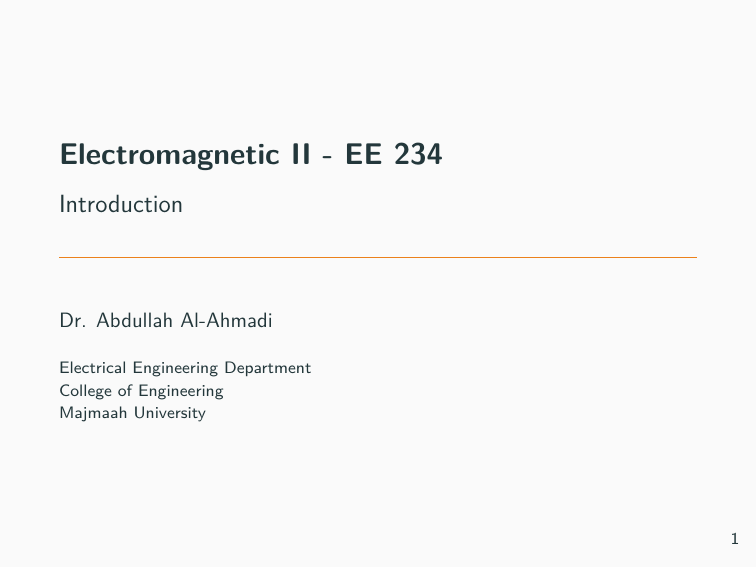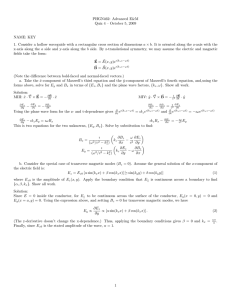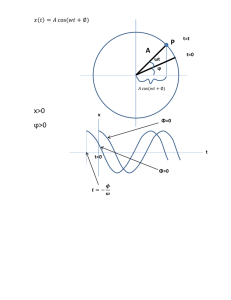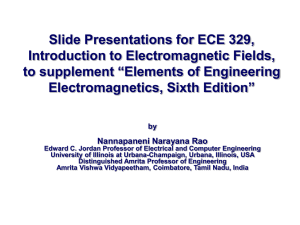Introduction
advertisement

Electromagnetic II - EE 234 Introduction Dr. Abdullah Al-Ahmadi Electrical Engineering Department College of Engineering Majmaah University 1 Introduction Electric Fields • The electromagnetic force consists of an electrical component Fe and a magnetic component Fm . • All matter contains a mixture of: • neutrons, • positively charged protons, • and negatively charged electrons, • Electric charge is measured is the coulomb (C). 2 • The magnitude of e is e = 1.6 × 10−19 (C) (1) • The charge of a single electron is qe = −e and that of a proton is equal in magnitude but opposite in polarity: qp = e 3 Coulomb’s law • Coulomb’s experiments: • Two like charges repel one another, whereas two charges of opposite polarity attract. • the force acts along the line joining the charges, and • its strength is proportional to the product of the magnitudes of the two charges and inversely proportional to the square of the distance between them. 4 Coulomb’s law Fe21 = R̂12 q1 q2 4πϵ0 R212 (N) (2) Figure 1: Electric forces on two positive point charges in free space. 5 • From Equation 2, Fe21 is the electrical force acting on charge q2 due to charge q1 when both are in free space (vacuum), • R21 is the distance between the two charges, • R̂21 is a unit vector pointing from charge q1 to charge q2 . • ϵ0 is a universal constant called the electrical permittivity of free space. ϵ0 = 8.854 × 10−12 farad per meter (F/m). • The force Fe12 acting on charge q1 due to charge q2 is equal to force Fe21 in magnitude, but opposite in direction: Fe12 = −Fe21 6 Electric Field Intensity E = R̂ q 4πϵ0 R2 (V/m) (3) Figure 2: Electric field E due to charge q 7 • To extend Equation 3 from the free-space case to any medium, E = R̂ q 4πϵR2 (V/m) (4) where R is the distance between the charge and the observation point • Often, ϵ is expressed in the form ϵ = ϵr ϵ0 (V/m) (5) • ϵr is a dimensionless quantity called the relative permittivity or dielectric constant of the material. For vacuum, ϵr = 1 8 Electric Flux Density D = ϵE (C/m2 ) (6) 9 Magnetic Fields Fact Electric charges can be isolated, but magnetic poles always exist in pairs. 10 Figure 3: Pattern of magnetic field lines around a bar magnet 11 • The magnetic lines surrounding a magnet represent the magnetic flux density B. • A magnetic field can also be created by electric current. • Danish scientist Hans Oersted (1777–1851), • observed that an electric current in a wire caused a compass needle to deflect. • direction was always perpendicular to the wire and to the radial line connecting the wire to the needle. 12 Figure 4: The magnetic field induced by a steady current flowing in the z direction 13 Biot–Savart law • Relates the magnetic flux density B at a point in space to the current I in the conductor. • The magnetic flux density B induced by a constant current I flowing in the z direction is given by: B = Φ̂ µ0 I 2πr (T) (7) • The magnetic field is measured in tesla (T), • µ0 is called the magnetic permeability of free space = 4π × 10−7 henry per meter (H/m) • Φ̂is an azimuthal unit vector 14 • the product of ϵ0 and µ0 specifies c, the velocity of light in free space: 1 c= √ = 3 × 108 (m/s) (8) µ0 ϵ0 15 • To extend Equation 7 from the free-space case to any medium, B = Φ̂ µI 2πr (T) (9) • µ is expressed in the form µ = µr µ0 (H/m) (10) • µr is a dimensionless quantity called the relative magnetic permeability of the material. 16 Magnetic Flux Density B = µH (11) where H is the magnetic field intensity 17 Static and Dynamic Fields Static describes a quantity that does not change with time. Dynamic refers to a quantity that does vary with time. 18 Table 1: The three branches of electromagnetics. 19 • Electrostatics and Magnetostatics: stationary charges and dc currents. • Dynamics: time-varying fields induced by time-varying sources. Fact A time-varying electric field generates a time-varying magnetic field, and vice versa. 20 Conductivity The conductivity (σ) characterizes the ease with which charges (electrons) can move freely in a material. • If σ = 0, the charges do not move more than atomic distances and the material is said to be a perfect dielectric. • if σ = ∞, the charges can move very freely throughout the material, which is then called a perfect conductor. • measured in siemens per meter (S/m). 21 • The parameters ϵ, µ and σ are often referred to as the constitutive parameters of a material (Table 2). • A medium is said to be homogeneous if its constitutive parameters are constant throughout the medium. Table 2: Constitutive parameters of materials 22 Traveling Waves Traveling Waves • Waves are of two types: 1. Transient waves caused by sudden disturbances. 2. Continuous periodic waves generated by a repetitive source. • one-dimensional wave: • If this disturbance varies as a function of one space variable. Figure 5. • A two-dimensional wave propagates out across a surface. Figure 6. • A three-dimensional wave propagates through a volume. Figure 7. • plane waves, cylindrical waves, and spherical waves. 23 Figure 5: A one-dimensional wave traveling on a string. 24 Figure 6: Circular waves 25 (a) Plane and cylindrical waves (b) Spherical wave Figure 7: Examples of two-dimensional and three-dimensional waves 26 • A traveling wave can be expressed as: ( ) 2πt 2πx − + ϕ0 y (x, t) = A cos T λ (m) (12) where: • • • • A is the amplitude of the wave. T is its time period λ is its spatial wavelength ϕ0 is a reference phase 27 • The phase velocity, also called the propagation velocity • The phase velocity up : up = λ T (m/s) (13) • The frequency of a sinusoidal wave, f , is the reciprocal of its time period T : 1 f= (Hz) (14) T • Combining Equations 13 and 14 yields: up = fλ (m/s) (15) 28 • Equation 12 can be written as: ( ) 2πx y (x, t) = A cos 2πft − + ϕ0 λ (m) = A cos (ωt − βx) (16) where ω is the angular velocity of the wave, and β is its phase constant (or wavenumber) ω = 2πf (rad/s) 2π β= (rad/m) λ 29 • The direction of wave propagation is determined by the signs of the t and x: • if one of the signs is positive and the other is negative, then the wave is traveling in the positive x direction. • if both signs are positive or both are negative, then the wave is traveling in the negative x direction. 30 Example The electric field of a traveling electromagnetic wave is given by ( ) E (z, t) = 10 cos π × 107 t + πz/15 + π/6 (V/m) Determine: 1. the direction of wave propagation, 2. the wave frequency f, 3. its wavelength λ 4. its phase velocity up . Answer 1. −z direction, 2. f = 5 MHz, 3.λ = 30 m, 4. up = 1.5 × 108 m/s. 31 Review of Complex Numbers Complex Numbers • Any complex number z can be expressed in rectangular form as: z = x + jy (17) • Alternatively, z may be cast in polar form as: z = |z| ejθ = |z| ∠θ (18) where |z| is the magnitude of zand θ is its phase angle 32 Euler’s identity ejθ = cos θ + j sin θ (19) • Applying Euler’s identity, we can convert z from polar form into rectangular form, z = |z| ejθ = |z| cos θ + j |z| sin θ (20) • This leads to the relations: x = |z| cos θ, y = |z| sin θ √ + 2 2 |z| = x + y , θ = tan−1 (y/x) (21) 33 • The complex conjugate of z z∗ = (x + jy)∗ = x − jy = |z| e−jθ = |z| ∠ − θ (22) • The magnitude |z| is equal to: |z| = √ + zz∗ (23) 34 Complex Algebra Equality If two complex numbers z1 and z2 are given by: z1 = x1 + jy1 = |z1 | ejθ1 z2 = x2 + jy2 = |z2 | ejθ2 then z1 = z2 if and only if x1 = x2 and y1 = y2 or, equivalently, |z1 | = |z2 | and θ1 = θ2 35 Addition z1 + z2 = (x1 + x2 ) + j (y1 + y2 ) Multiplication z1 z2 = (x1 x2 − y1 y2 ) + j (x1 y2 + x2 y1 ) or z1 z2 = |z1 | |z2 | ej(θ1 +θ2 ) = |z1 | |z2 | [cos (θ1 + θ2 ) + j sin (θ1 + θ2 )] 36 Division For z2 ̸= 0 (x1 + jy1 ) (x2 − jy2 ) z1 = . z2 (x2 + jy2 ) (x2 − jy2 ) (x1 x2 + y1 y2 ) + j (x2 y1 − x1 y2 ) = x22 + y22 or z1 |z1 | j(θ1 −θ2 ) = e z2 |z2 | |z1 | [cos (θ1 − θ2 ) + j sin (θ1 − θ2 )] = |z2 | 37 Powers For any positive integer n, ( )n zn = |z| ejθ = |z|n ejnθ = |z|n (cos nθ + j sin nθ) z1/2 = ± |z|1/2 ejθ/2 = ± |z|1/2 [cos (θ/2) + j sin (θ/2)] 38 Useful Relations −1 = ejπ = e−jπ = 1∠180◦ j = ejπ/2 = 1∠90◦ −j = −ejπ/2 = e−jπ/2 = 1∠ − 90◦ )1/2 ( √ ± (1 + j) √ j = ejπ/2 = ±ejπ/4 = 2 √ ± (1 − j) √ −j = ±e−jπ/4 = 2 39 Example Given two complex numbers V = 3 − j4 I = − (2 + j3) 1. Express V and I in polar form 2. Find VI 3. Find VI∗ 4. Find V/I √ 5. Find I Solution ◦ 1. V = 5∠ − 53◦ , I = 3.61∠ − 123.69◦ 2. VI = 18.03ej183.2 3. √ ◦ ◦ ◦ VI∗ = 18.03ej70.6 4. V/I = 1.39ej70.6 5. I = ±1.90ej118.15 40 Review of Phasors Solution Procedure Step 1: Adopt a cosine reference. Table 3. Step 2: Express time-dependent variables as phasors. Table 4 Step 3: Recast the differential / integral equation in phasor form Step 4: Solve the phasor-domain equation Step 5: Find the instantaneous value 41 Table 3: Trigonometric Relations 42 Table 4: Time-domain sinusoidal functions z (t) and their e cosine-reference phasor-domain counterparts Z 43 Example The voltage source of the circuit shown in figure below is given by: ( ) vs (t) = 5 sin 4 × 104 t − 30◦ (V) Obtain an expression for the voltage across the inductor. Solution ( ) vL (t) = 4 cos 4 × 104 t − 83.1◦ (V) 44




